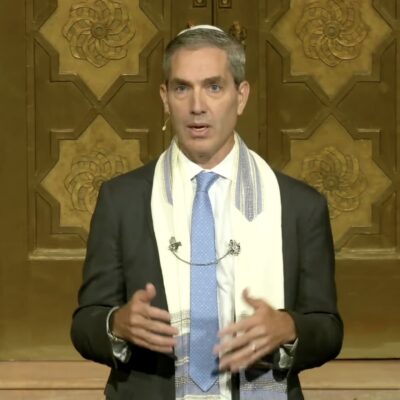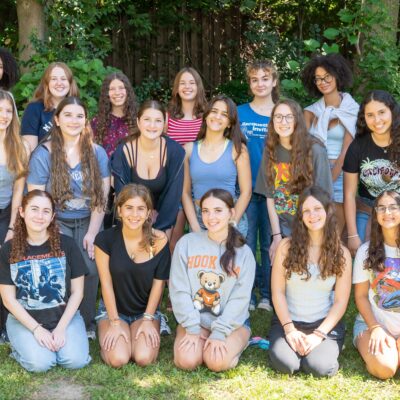The New American Jewish Gilded Age:
Examining Wealth, Anti-Semitism, and More

By Steven Windmueller, Ph.D.
“The first Gilded Age saw massive wealth inequalities, hyper-partisanship, virulent anti-immigrant sentiment and growing concern about money in politics.”[1] It also witnessed a significant uptake in anti-Semitic behavior!
Some American economists are defining this current period of affluence and growth as our nation’s “second gilded age.” The first “Gilded Age” followed the Civil War (1870-1900) and it would be marked by greed and corruption often at the expense of the working class. With the growing political influence of the business and industrial sector, the “Robber Barons” would employ their economic clout. Intimidation was used to exploit workers and to hold down wages. The economic divide of that era is being recreated in today’s American marketplace, as we are experiencing the most significant income inequality in this nation’s history.[2]
During the period following the Civil War, “the US Army accelerated long-running efforts to expel Native Americans from ancestral lands across the continent, sometimes claiming to be fighting ‘barbarism and terrorism’ as a pretext for Gilded Age projects of occupation and natural resource extraction.”[3] We are reminded that similar policies are in effect at this time in connection with Indian lands and access to mineral reserves.
Between 1860 and 1900, U.S. factory output soared from $1.9 billion to $13 billion, an increase of nearly 600 percent. By 1900 the U.S. boasted the most powerful industrial economy in the world. In recent decades, America has experienced a similar economic boom, interrupted by periodic recessions, similar to the patterns found in the late 19th Century.
Just as with this current moment, the Gilded Age was not only bolstered by a growth-based economy but also by the new technologies of that era. If steel reshaped the industrial economy of the last three decades of the 19th century, then the “digital economy” is framing the growth associated with this contemporary marketplace.
If the first Gilded Age produced a cadre of prominent business tycoons, innovators and inventors, “most certainly this second era of affluence has produced its own list of economic power players.” In this environment, individual American entreprenaurs, including a number of prominent Jews such as Larry Page, Sergey Brin, Marc Benioff, Mark Zuckerberg, Larry Ellison, Sheryl Sandberg, and Michael Dell are contributing to the remaking of this nation’s economy. During the first Gilded Age, names such as Vanderbilt, Rockefeller and Carnegie would similarly dominate the economic scene, as would such prominent Jews as Julius Rosenwald, Jacob Schiff, Oscar Straus, and Joseph Seligman.
“But if the Gilded Age was characterized by great enthusiasm, it was likewise an age marked by intense anxiety. That’s because many believed that beneath all the gold and glitter one found disturbing economic, social and political trends.”[4] Mark Twain would formally name this era, the ‘Gilded Age.’ Like a piece of gilded jewelry, it looked beautiful on the outside. But beneath the thin veneer of gold lay cold black iron.”[5]
Taking a Deeper Dive
While this current economy has been expanding, providing new job opportunities for many, some economists and a few social scientists offer a different perspective. They are suggesting that there is growth but the “trickle down” impact is minimal and that many working class households are living at or near the poverty line. Data from the New York Jewish Population Study and from other demographic reports offers some sobering news in connection with the presence of the “new Jewish poor” or “near poor.” In some cases, elderly and disabled individuals on fixed incomes and pensions are no longer able to provide for themselves. Some of this maybe tied to the inability of some families to have recovered from the 2008 “great recession.” Data about recent college-graduates and young families provide additional insights about the negative impact of college loans, the inability to afford housing, the high costs of medical coverage, and the limited options of certain professions within this job market.
Anti–Semitism: Old and New
In reaction to the economic picture of the late 19th century, one can document the rise of populist protestors, the growth of the Klan and the presence of grass roots anti-Semitism, all reflective of the political climate of this nation during that time frame. Jews would be blamed as “globalists” for their international financial connections and the beliefs associated with their “control” over banking and trade. Following the Panic of 1873, agrarian radical activists depicted cities as the cause of America’s economic problems, asserting, “Jews were the essence of urban corruption.”
Historian Hasia Diner reports that in the 1890’s “marauding bands viciously beat a number of Jewish storekeepers in the rural South.” Accusing Jews among others of owning two thirds of “their” land, agrarian activists carried out a series of violent actions known as “rural anti-Semitism.”[6]
“Doctrines of white supremacy singled out Anglo-Saxons for special praise, fostering suspicion of Italians, Jews, Slavs, and other non-Anglo immigrants and laying the groundwork for immigration restriction. But unlike American Indians, whose remnants had been confined to reservations, and Asians, who were excluded altogether, European immigrants could at least claim that they were Caucasian. And by 1900, the word ‘Caucasian’ was well on the way to becoming synonymous with ‘American.’”[7]
The current uptake in anti-Semitic attitudes and actions reflects some of the same themes found in the 19th Century period. “Jewish control” over media, the economy and politics are reflected in the hate mantra of the 21st Century. The status of Jewish “whiteness” has once again become a talking point in anti-Semitic literature and discourse.
The New Jewish Wealth
One of the outcomes of this second Gilded Age is the emergence of a new Jewish wealth elite. There is no way to systematically track the accrual of this sector’s wealth and its total distribution of charitable dollars into the society. Nor are we able at this point to measure its full impact on the cultural and political life of our community.
So, how does this accumulation of wealth impact Jews? As Jack Wertheimer has suggested in his study on Jewish giving:
The dramatic expansion and diffusion of big giving have made it difficult for all but the most engaged insiders to keep track of the rapidly changing field. A variety of new players with diverse interests have entered the scene, a hodgepodge of funder-created initiatives dot the landscape, and an ever changing set of partnerships characterize big giving, so much so that Jewish philanthropy now resembles a kaleidoscope, with ever-changing optics.[8]
Often operating under the radar, this sector is positioning itself to play critical roles both within the economic system and the political sphere.
“Closet Republicans”
As a result of the current economic boom, a group of political scientists are positing that some voters, including a segment of Jews, who might normally embrace Democratic candidates are currently “leaning Republican.” Known as “closet voters ” these individuals are experiencing the benefits of this economy and remain nervous about any political change at this point that might curtail the economic benefits accrued to them and their friends under the Trump Presidency. Regardless of their personal views concerning this President or any disagreements that they may have with some of his actions, these voters are expressing confidence in the state of this nation’s economic wellbeing. These “Gilded Jews” are enjoying the benefits of this economic expansion. Working off of the assumption that voter preferences are framed in connection with one’s pocketbook, this voting thesis has drawn some significant attention.
Radicalized Politics
The radicalization of politics represents one of the outcomes of this new economic age! There has been a decided uptake in the number of individuals who have reacted negatively to the economic trends in this society, prompting them to become more radicalized in their opposition to the status quo. The rise of the “progressive wing” of the Democratic Party reflects a particular response to this era in American life.[9]
In this new Gilded Age, many Jews have been the beneficiaries of this economic moment. Yet, others are experiencing the changing realities of a marketplace increasingly caught up in tariff wars, stagnant wages, and changing economic fortunes. In this period, one sees Jews among others becoming politically radicalized in response to the growing economic disparities within this society and the political turmoil in connection with this administration. Similar political and cultural movements that shaped the late 19th Century, Populism[10] and Progressivism[11] in particular, may emerge in response to the social and economic challenges of the 21st Century.
End Notes
As with Americans in general, Jews are experiencing the full impact of this “Gilded Age” moment. Some are the beneficiaries of this economy, others less so! The fall-out over economic excess, political corruption, and social disruption is having its own impact on American society in general and within our Jewish community, in particular.
Just as we are witnessing the rise of an American Jewish economic elite, there is the growing presence of a new era of home grown anti-Semitism. As with the first Gilded Age, this is an age of extremes and uncertainties.
Steven Windmueller is the Rabbi Alfred Gottschalk Emeritus Professor of Jewish Communal Service at the Jack H. Skirball Campus of HUC-JIR, Los Angeles. His writings may be found on his website: www.thewindreport.com.
[1] https://www.vox.com/first-person/2019/4/1/18286084/gilded-age-income-inequality-robber-baron
[2] Ibid.
[3] Ibid.
[4] Ibid
[5] https://www.history.com/news/second-gilded-age-income-inequality
[6] Hasia R. Diner, The Jews of the United States: 1654-2000 (Berkeley: University of California Press, 2004), pages 170-171
[7] https://ap.gilderlehrman.org/essays/gilded-age
[8] https://avichai.org/wp-content/uploads/2018/03/Giving-Jewish-Jack-Wertheimer.pdf
[9]https://www.theatlantic.com/ideas/archive/2019/04/progressivism-making-democrats/586372/
[10] https://www.britannica.com/topic/populism
[11] https://www.heritage.org/political-process/report/the-progressive-movement-and-the-transformation-american-politics

 Add EJP on Google
Add EJP on Google









